SaaS Management
• 8 min read
5 SaaS Management Best Practices (2024 Edition)
15th February, 2024
SHARE ON:
Organizations and their workforce rely extensively on SaaS tools to power their day-to-day business operations, enjoying benefits like scalability and cost-efficiency. However, this widespread usage presents challenges, particularly in security, cost control, and management. This post lists 5 essential SaaS management best practices to manage your SaaS stack effectively.
SaaS applications have transformed the way organizations manage their daily operations. They offer unparalleled flexibility, efficiency, and scalability, making them indispensable tools for organizations of all sizes. Yet, while SaaS applications have brought tremendous benefits, they have ushered in new challenges. Among these challenges, one that looms large is the issue of unmanaged SaaS. When left unchecked, unmanaged SaaS can cast a shadow over an organization, leading to many problems that affect everything from security to efficiency.
This post aims to empower IT teams with actionable insights and a holistic understanding of SaaS management best practices, enabling you to make informed decisions and optimize the usage of SaaS applications within your organization in 2024 and beyond.
What Is SaaS Management?
The process of optimizing an organization's decentralized, unmanaged SaaS stack and its usage is known as SaaS management. SaaS management involves tasks such as tracking SaaS apps, licenses, and subscriptions, monitoring usage, controlling costs, ensuring security and compliance, and managing user access to maximize the value and efficiency of SaaS tools while minimizing risks and expenses.
Overall, SaaS management is pivotal in aligning SaaS investments with business goals and ensuring an organization's efficient, secure, and cost-effective operation of cloud-based software.
Key Components Of Successful SaaS Management Process
SaaS management involves several key components and processes:
Inventory and Discovery: SaaS management starts with creating a comprehensive inventory of all SaaS applications in use across the organization. This involves identifying corporate-owned apps and any shadow IT applications that employees may use without formal approval.
Usage and Adoption Monitoring: Monitoring how SaaS applications are used is crucial. SaaS management includes tracking user adoption rates, how frequently applications are used, and whether they align with the organization's goals. Understanding usage patterns helps in making informed decisions about renewals or cancellations.
Cost Management: Managing SaaS costs involves tracking expenditures, identifying unused or underutilized subscriptions, and negotiating contracts to optimize spending. Cost management is critical to ensure that the organization is getting value for its investments.
Security and Compliance: SaaS management prioritizes security and compliance by enforcing access controls, data encryption, and regular security assessments to mitigate legal and financial risks.
User Access Control: SaaS management also includes overseeing user access and permissions, ensuring that employees only have access to SaaS tools relevant to their roles to minimize the risk of data breaches.
The need for SaaS management in today's booming business scenario cannot be stressed enough. Before we dive into the SaaS management best practices, let's learn why it is of utmost importance for organizations to streamline their SaaS processes.
Why Do Organizations Need SaaS Management?
While SaaS offers unparalleled flexibility and efficiency, it also presents unique challenges in terms of cost control, security, compliance, and optimization. This has raised the essential question: Why do organizations need SaaS management? Here are a few reasons organizations need to implement SaaS Management strategies:
1. Minimizes Shadow IT
Shadow IT refers to the applications or systems purchased or developed within a company without the explicit consent or knowledge of the IT department.
SaaS management helps organizations gain control over shadow IT and prohibits employees' unauthorized or unmanaged use of SaaS applications. It doesn't just stop at blocking unapproved applications; it also suggests and promotes approved alternatives. SaaS management can identify and recommend official, secure, and compliant alternatives if employees use unapproved tools for specific tasks.
Proper SaaS management also involves educating employees about the risks associated with Shadow IT and the proper channels for software procurement. Training programs can help raise awareness and encourage compliance.
Organizations can minimize the risks associated with unapproved applications by maintaining a comprehensive SaaS inventory and enforcing access controls, ensuring data security and compliance.
2. Broader Visibility Into Operations
Procurement and IT teams require comprehensive understanding and transparency within the SaaS ecosystem. This understanding helps pinpoint applications that bring a positive return on investment (ROI) and determine which applications are non-essential for business units.
Effective SaaS management provides organizations with a holistic view of their software landscape. It facilitates complete visibility in all the SaaS user licenses, ownership, contracts, renewals, and associated expenses. This broader visibility enables better decision-making by understanding which applications are essential for operations, which can be optimized, and which may no longer align with business goals.
Further, it helps you optimize your SaaS usage through valuable insights, like– finding possible redundant applications, integrating SaaS usage to save license costs, discovering any functional gaps in your SaaS portfolio, and more.
3. Effective License Management
An evolving organization uses hundreds of SaaS applications to support its operations. Over time, managing various software licenses becomes challenging. Without proper SaaS management, they might inadvertently overpay for unused licenses or lack visibility into critical subscriptions. SaaS management ensures that licenses are optimized, helping organizations save costs and efficiently allocate resources.
By meticulously overseeing the entire lifecycle of software licenses, proper SaaS management ensures that licenses are not only procured efficiently but are also meticulously tracked and optimized. This optimization extends to reallocation, scaling down, or upgrading licenses based on evolving business needs. Consequently, organizations save costs and allocate resources judiciously, thereby bolstering their financial resilience and operational efficiency.
4. Keeps Data Secure & Mitigates Risks
Data breaches and cybersecurity threats are ever-present concerns for organizations. SaaS applications often store sensitive information, and poor security practices can lead to significant risks. In addition, third-party vendors provide security plugins for enterprise applications that can easily be overlooked.
SaaS management prioritizes data security by implementing robust access controls, encryption, and regular security assessments. For instance, access controls ensure only authorized personnel can access sensitive data within SaaS applications. Encryption secures data both in transit and at rest, rendering it unreadable to unauthorized parties. Regular security assessments help identify vulnerabilities and enable timely remediation.
This proactive approach minimizes the potential for data breaches, ensuring compliance with regulations and safeguarding the organization's reputation.
5 Proven SaaS Management Best Practices For IT Teams
SaaS management best practices are a set of guidelines and strategies that organizations should follow to effectively govern, optimize, and secure their SaaS applications. These practices help ensure that SaaS tools are used efficiently, securely, and in alignment with the organization's goals.
Here are five key SaaS management best practices:
1. Centralize SaaS Operations
A centralized system is an ideal way to provide visibility across the SaaS stack in your organization. This provides a comprehensive view of user identity and access across organizational resources and applications. But when several operations coincide, IT teams should have a more comprehensive insight across all identities. This can be resolved. How do you ask? IT admins can track user behavior and identify anomalies across all workloads with one central platform.
This approach provides a holistic view of user identities and access to various resources and applications used across the organization. IT teams need a comprehensive understanding of all user identities when multiple operations occur simultaneously. This can be achieved by tracking user behavior and detecting any unusual or anomalous activities across all workloads using a single central platform.
Is there any tool that helps you with this?
Zluri is a SaaS management platform that helps IT teams discover, optimize, and secure their SaaS applications. Its exceptional data accuracy sets Zluri apart as the best SaaS management platform.
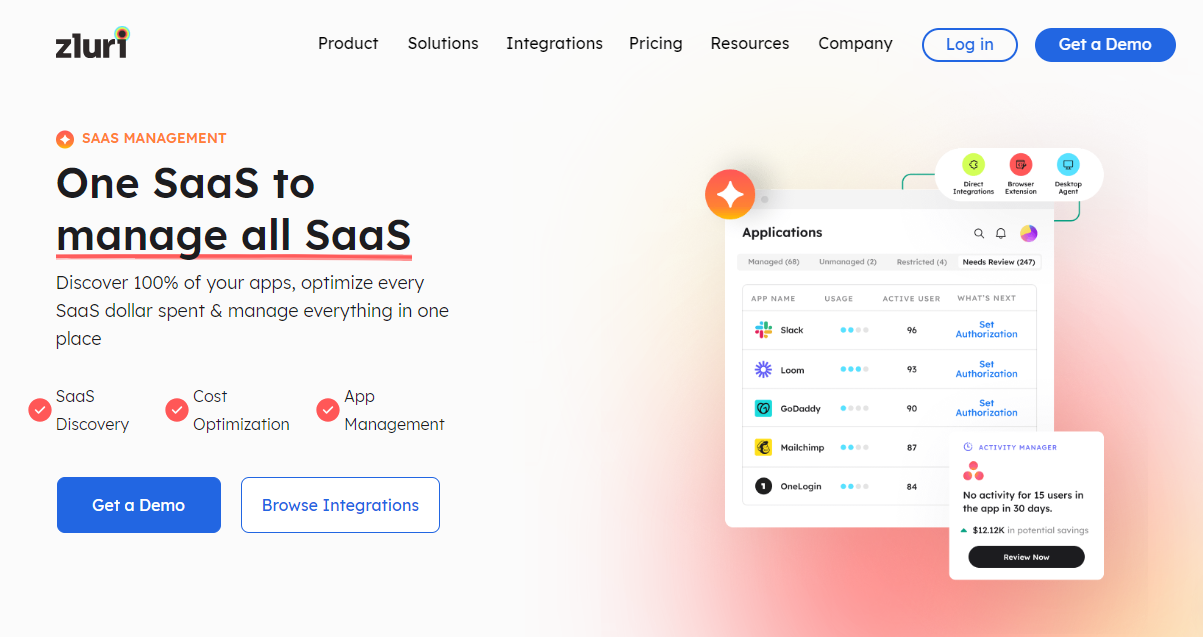
It boasts the world's largest collection, with a vast library of over 250,000 SaaS apps. Zluri utilizes five different discovery methods to identify 100% of the SaaS applications within your organization. These methods include single sign-on (SSO), integration with finance and expense management systems, direct integration with apps, desktop agents (optional), and browser agents (optional).
To sum up, by centralizing all SaaS operations under a unified platform, Zluri aids in eliminating shadow IT and efficiently managing your company's SaaS applications. It offers features to help address and resolve SaaS-related issues, manage SaaS apps effectively, and gain a complete picture of your SaaS infrastructure. Thus, Zluri empowers you to take control of your organization's SaaS ecosystem.
2. Eliminate SaaS App Redundancies
One crucial step in SaaS management is purchasing the right applications. You may begin locating overlaps and redundancies by empowering yourself with the list of SaaS applications utilized throughout the firm and deep insights into SaaS usage levels.
When two teams have a common everyday task but differ in their choice of tools to accomplish it, it's an opportunity for analysis. Simplify the process by evaluating which of the two tools is better suited for the task. Engage with all stakeholders, present your findings, and advocate for transitioning to a more suitable tool to streamline operations.
But you need to know the actual use of apps to differentiate redundancies or identify specific areas that are being overutilized. To accomplish results, you must thoroughly examine each app and its potential use cases.
Zluri can significantly assist in this step. Zluri's extensive SaaS management capabilities enable you to gain visibility into the entire spectrum of SaaS applications used in your organization.
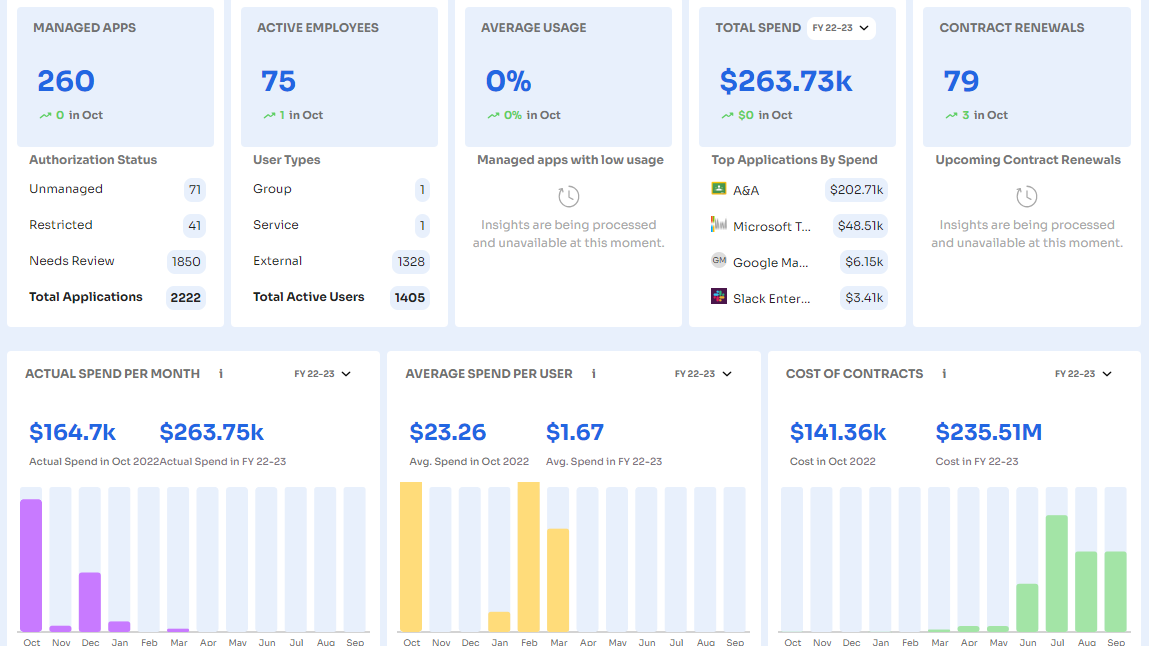
It provides insights into actual app usage patterns, helping you identify redundancies and areas of overuse. With Zluri, you can make data-driven decisions, facilitate discussions with stakeholders, and streamline the transition to more efficient SaaS tools where necessary, thus optimizing your SaaS ecosystem effectively.
3. Control & Manage SaaS Spend
While moving to the cloud may seem like a money-saving move, it's important to be aware of the actual financial effects and management challenges tied to SaaS expenses. This is vital if you want to run your business efficiently on a budget.
Fortunately, Zluri simplifies this task for you. It comprehensively understands your SaaS ecosystem and recommends more cost-effective and superior SaaS applications. Beyond expense management, Zluri also keeps a vigilant eye on the usage and associated costs of the licenses you employ.
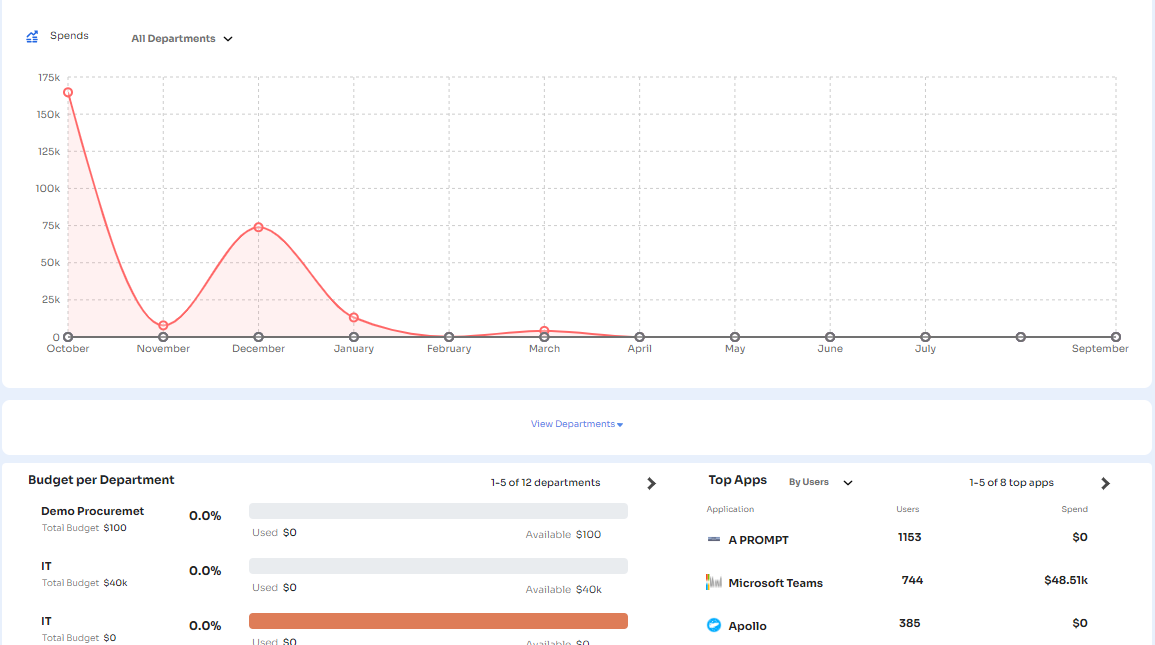
Notably, how many SaaS management systems proactively update their pricing plans in response to changes? Zluri does just that. It continuously updates its records, whether it's for incorporating new SaaS tools or reflecting price adjustments in existing subscriptions. Moreover, it provides a spending analysis and a comprehensive breakdown of total costs per department, enabling you to identify budget disparities and make well-informed decisions.
Say goodbye to unforeseen costs and extra SaaS spending, as Zluri keeps you well-informed even before renewal deadlines approach. This gives your IT teams ample time to make informed decisions about retaining or removing specific apps, ultimately saving you money.
4. Automate Your SaaS Workflows
If you are in charge of IT, you must ensure that employees use their time and effort effectively on complex tasks that can be automated easily. The focus should always be on looking for ways to cut the mundane tasks out of your day so that your employees can entirely focus on the creative aspects of your work. IT have enabled automating routine operations like onboarding and offboarding, requesting new software programs, etc.
IT and HR teams no longer have to undergo repetitive and time-consuming onboarding procedures like introducing new users to SaaS apps. Zluri’s SaaS Management platform makes it easy to provide access to apps to new employees. Since the system has lots of data, its workflow automation enables users to construct customized workflows.
Zluri offers seamless integration with existing HR systems to enhance IT team efficiency. Through Zluri, IT teams can effortlessly link with platforms like Bamboo HR, BreatheHR, Zoho Recruit, and others, accessing valuable information such as onboarding details and employee data within the organization.
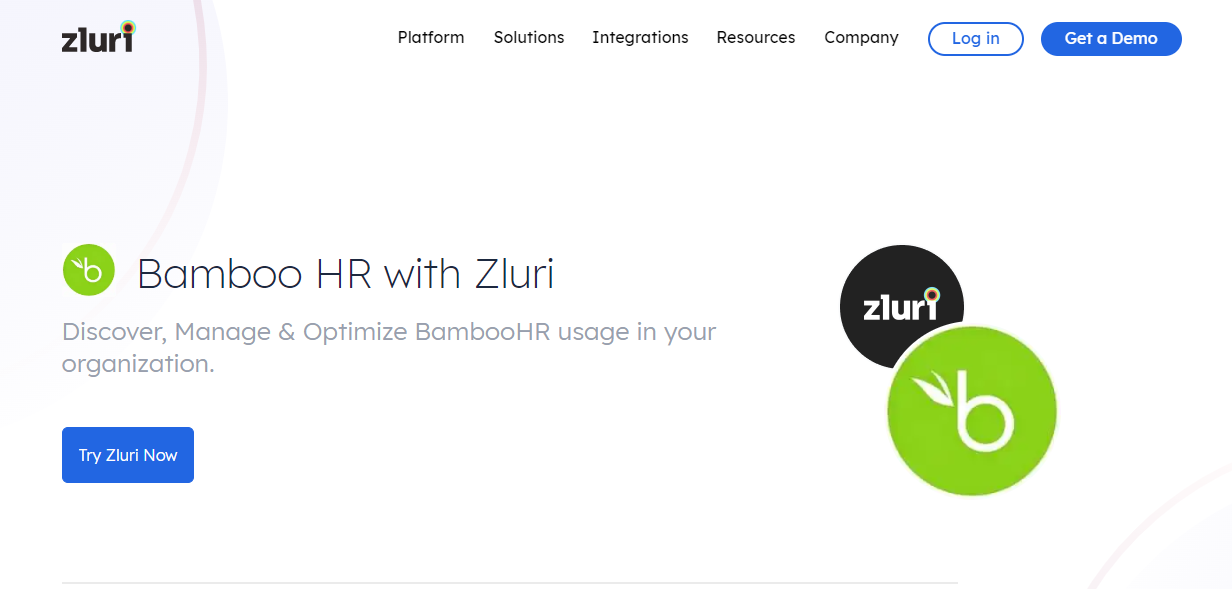
For example, during employee onboarding, it examines the new employee's job profile, seniority, and department and grants access to applications based on that rather than utilizing generic templates that complicate things.
Further, Zluri gives app suggestions when onboarding workflows based on seniority and department. You need to know that it also offers in-app suggestions, like what projects, channels, and groups to add them to. Automation at its best!
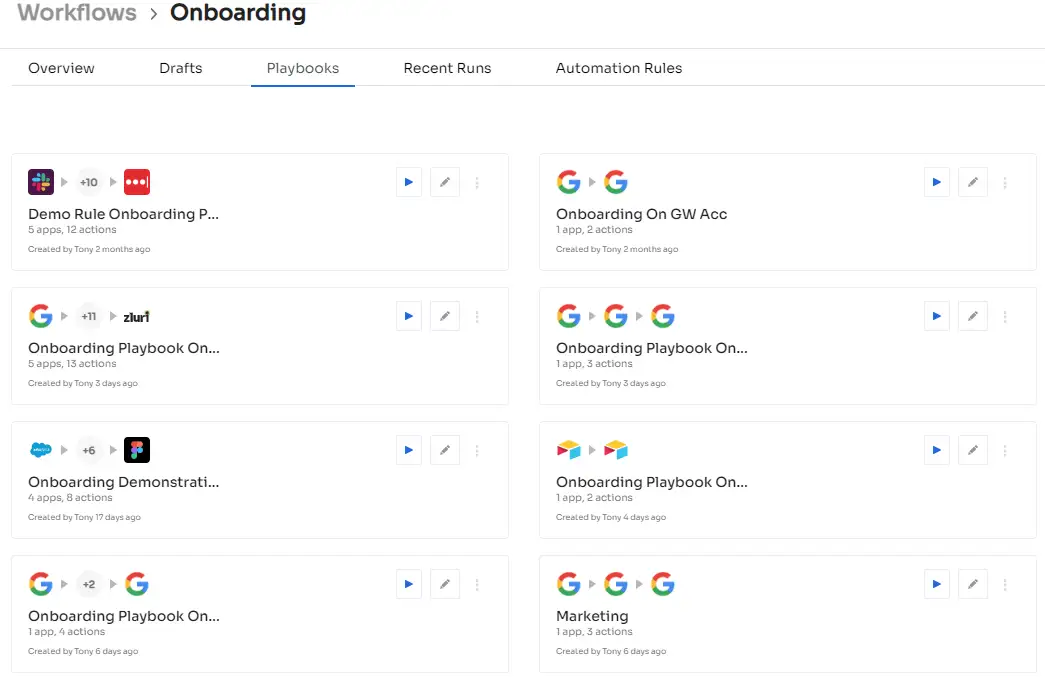

There's more! These processes can also be stored as playbooks. You can use the playbook and grant access to the tools the next time a new employee is hired for the same position. Furthermore, access can be authorized according to predefined roles and permissions, guaranteeing that only individuals with the appropriate credentials can utilize the designated tools.
Similarly, when an employee departs from the organization, Zluri facilitates a swift offboarding process, reducing the timeframe from days to hours. It also automates the revocation of all the departing employee's SaaS licenses, mitigating the risk of unauthorized access to company apps and enhancing data security.

Zluri also ensures that a user's access is terminated from all the apps they were using from the SSO or Google workplace account when they leave the company and backs up the data for future requirements.
Additionally, transferring ownership of active SaaS app licenses or data becomes a seamless task, and integration with cloud directories enables efficient storage, utilization, and sharing of data through cloud services.
5. Streamline SaaS Vendor Management
Effective SaaS vendor management is critical to optimizing your organization's SaaS ecosystem. It involves the strategic oversight and coordination of the relationships between your organization and the various SaaS vendors providing software solutions.
Regularly assess the performance of your SaaS vendors. Evaluate their ability to meet service level agreements (SLAs) and provide timely support when issues arise. Ensure that your vendors meet SaaS security and compliance standards relevant to your industry. Understand their data protection practices and their commitment to safeguarding your sensitive information.
Zluri serves as a single source of truth for vendor contracts, offering convenient access to metadata that aids in cost reduction and boosts overall return on investment (ROI).
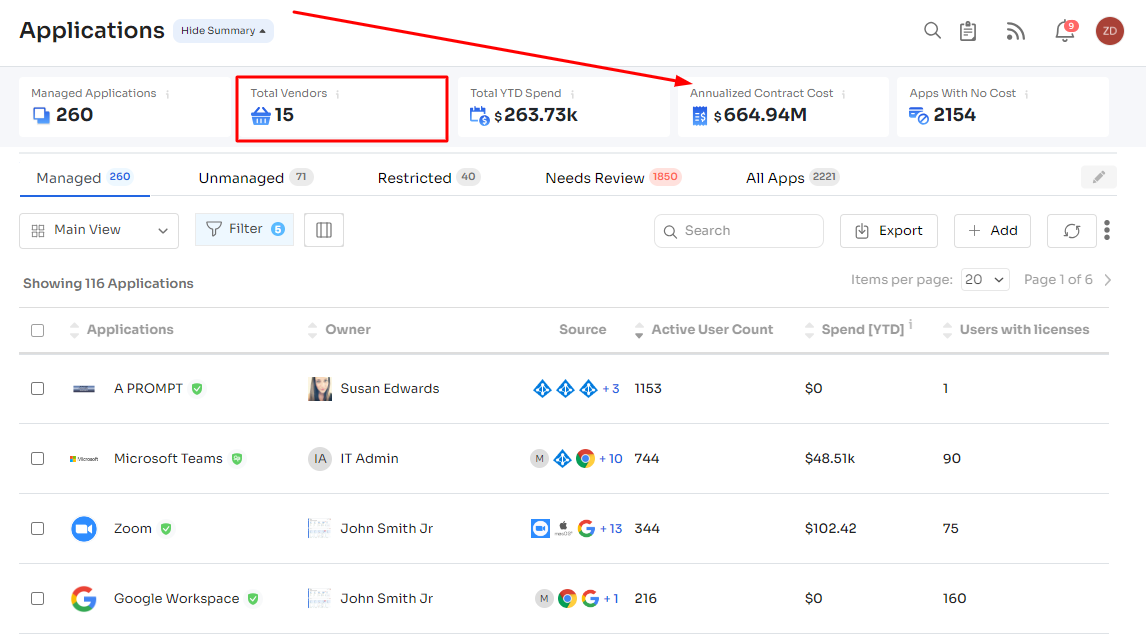
With Zluri, you can easily track the status of your contracts, distinguishing between active and expired ones. All contract details are stored alongside other vendor information, ensuring quick access whenever needed–during renewals, audits, or terminations. In cases where you've acquired multiple applications from a single vendor, Zluri can assist in negotiating more favorable terms.
Renewal monitoring is an integral aspect of vendor management facilitated by Zluri. It allows you to efficiently manage renewals by establishing an approval process that curbs unnecessary spending.

Zluri offers a renewal calendar consolidating upcoming renewals and contracts, simplifying your oversight. You can configure email alerts, set at 30 days or a custom timeframe, to ensure you never overlook a renewal, thereby guaranteeing uninterrupted services. Moreover, it aids in prioritizing high-value contract renewals, helping you prepare adequately.
By following these SaaS management best practices, IT teams can unlock the full potential of their SaaS investments. Schedule a demo today with Zluri and experience it firsthand.
Related Blogs
See More
Subscribe to our Newsletter
Get updates in your inbox
